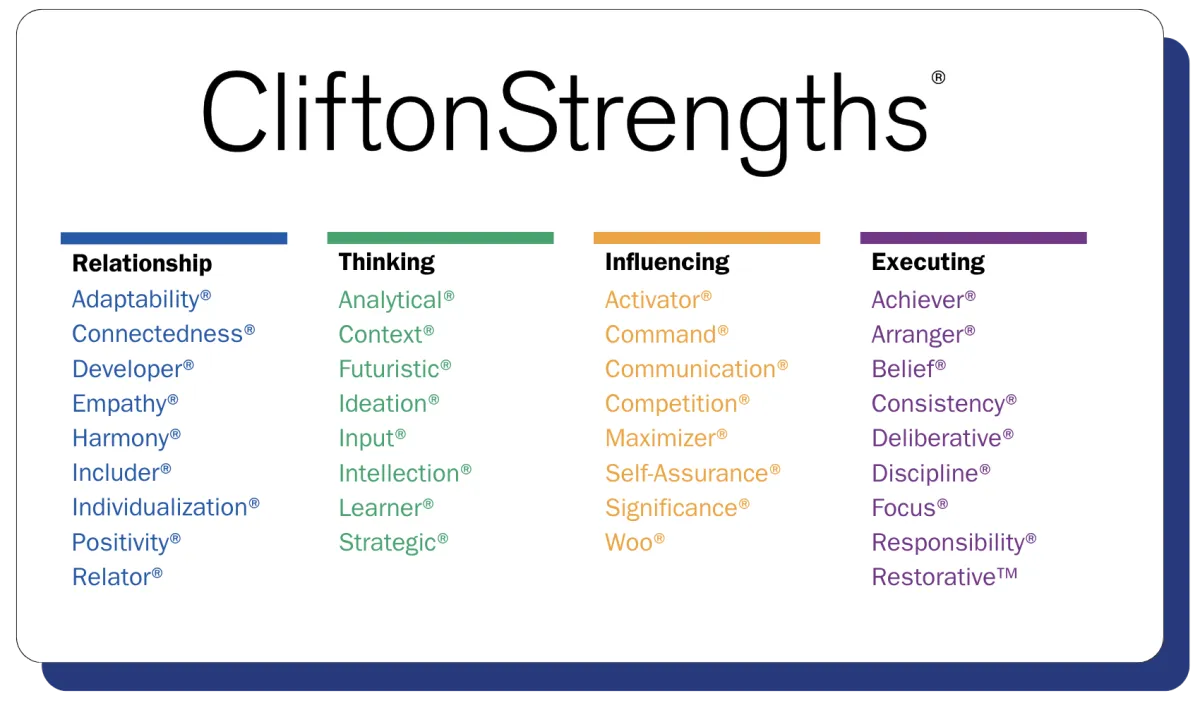
CliftonStrengths Is Just the Beginning.
Most people who take the CliftonStrengths assessment walk away inspired. Reading those results can feel like seeing yourself clearly for the first time. It reveals the themes that drive how you think, feel, and behave, your natural patterns that can contribute to excellence. But for many, that is where the journey stops. They glance through their report, nod in recognition, and move on. Awareness feels like progress, but awareness alone does not create growth.
Understanding your themes is the beginning of the work, not the end of it. True transformation happens when we begin to apply our strengths intentionally, when we move from knowing our potential to using it in a way that aligns with purpose, outcomes, and methods. In the language of Positive Leadership, that is where engagement begins.
Strengths Without Application Are Untapped Resources 🚰
Every talent theme, whether Strategic, Empathy, Responsibility, or Ideation, represents potential energy. But like potential energy, it does not create impact until it is converted into motion. The purpose of knowing your strengths is not to admire them but to apply them. In Positive Leadership, we describe this as engagement, the deliberate investment of your resources, time, focus, relationships, and talent, into the factors necessary for thriving. Awareness of strengths identifies your internal resources. Engagement determines how well you use them.
A leader might know that Individualization is one of their top themes, but if they never take the time to understand each person on their team, that talent remains dormant. Similarly, someone with Achiever may take pride in their stamina and drive, but without reflection, they may push so hard that they lose alignment with the bigger picture. In both cases, self-awareness must evolve into self-leadership.
Awareness Builds Confidence. Application Builds Competence
The gap between awareness and growth is filled by practice. You cannot think your way into mastering a strength; you have to use it, observe its impact, and refine it. This is where the Performance Ladder becomes useful. Each strength can be expressed at different levels of performance, from basic to competent to advanced. Awareness lives at the lower rungs, while practice and reflection move you upward. As you consciously apply a strength, you learn what conditions help it thrive and what overuse or underuse looks like.
For example, someone strong in Analytical may initially rely heavily on data before making decisions. With practice, they learn to integrate empathy or intuition to balance that analysis. A strength becomes powerful when it is flexible, when it adapts to the context, and serves a larger purpose. Competence, therefore, is not about doing more with your strengths; it is about doing the right things with them.
The Connection Between Strengths and Alignment 🎯
Progression Theory teaches that thriving occurs when purpose, outcomes, and methods are aligned. Strengths play a role in each of these stages. Purpose clarifies what matters most. Strengths reveal the activities that give you energy and meaning, the spaces where you naturally contribute at your highest level. Outcomes define what thriving looks like for you and your organization. Strengths guide you toward goals that are both fulfilling and sustainable. Methods are where strengths are converted into action. Each strength can influence the way you plan, communicate, or execute. When your strengths align with purpose and outcomes, you move from motion to meaningful action.
Leaders who use this alignment model do not just focus on using strengths; they consider whether their use of strengths serves the right purpose. That reflection is where growth happens.
The Misuse of Strengths: When Talents Turn into Traps 🪤
The more we rely on our strongest talents, the more likely we are to overuse them. A person with Command can inspire confidence through decisive action, but in excess, that same trait can silence collaboration. Someone with Harmony may defuse conflict, yet avoid essential tension that fuels growth. Every strength contains a shadow side, the point where comfort becomes complacency or dominance. Recognizing these patterns is essential because unexamined strengths can limit progress just as much as weaknesses do.
Positive Leadership invites us to ask a deeper question: are my strengths creating thriving or preventing it? That reflection transforms self-awareness into wisdom.
Turning Strengths into Strength 🏋️♂️
The goal is not to use your strengths more, but to use them better. Positive Leadership introduces a progression-based view of growth: perfection is never possible, but progression is always possible. Every strength can be developed through continuous alignment and engagement.
The COIN model (Connect, Observe, Interrupt, and Nuance) offers a helpful path forward. Connect means linking the situation to purpose and people so that feedback or action is grounded in relationship and shared outcomes. Observe means noticing thoughts, feelings, behaviors, and results with accuracy, so you see what is actually happening rather than reacting to assumptions. Interrupt means pausing unhelpful patterns and choosing a different response that aligns with purpose and desired outcomes. Nuance means refining your approach based on context and learning, so your use of strengths becomes more precise and effective over time.
From Strengths Awareness to Leadership Practice ✍🏻
When people use their strengths well, engagement rises. They experience a stronger sense of contribution and alignment with purpose. But leaders who intentionally cultivate strengths, both their own and those of their teams, create something larger. They create momentum. Teams that understand and apply their strengths effectively do not just perform better; they experience more trust, collaboration, and resilience. They are less focused on hierarchy and more focused on contribution. Using strengths well is not merely a developmental exercise; it is a leadership practice.
A thriving organization is one where people know their strengths, apply them purposefully, and see how their unique contributions connect to shared outcomes. This is where individual potential transforms into collective progress.
Strengths Awareness Is the Doorway, Not the Destination 🔑
CliftonStrengths provides language. Talent2Strength provides a path. Growth requires movement, the deliberate act of turning awareness into alignment and alignment into thriving. Every leader has a choice: to treat their strengths as labels or as levers. Labels describe who we are. Levers help us create change.
Your strengths are powerful, but their purpose is bigger than insight. They are meant to be engaged intentionally, purposefully, and in service of thriving. In Positive Leadership, growth is never about being more of what you already are. It is about progressing toward what you are capable of becoming.
